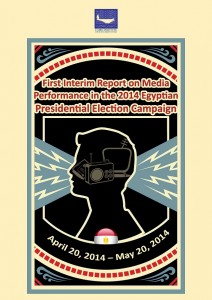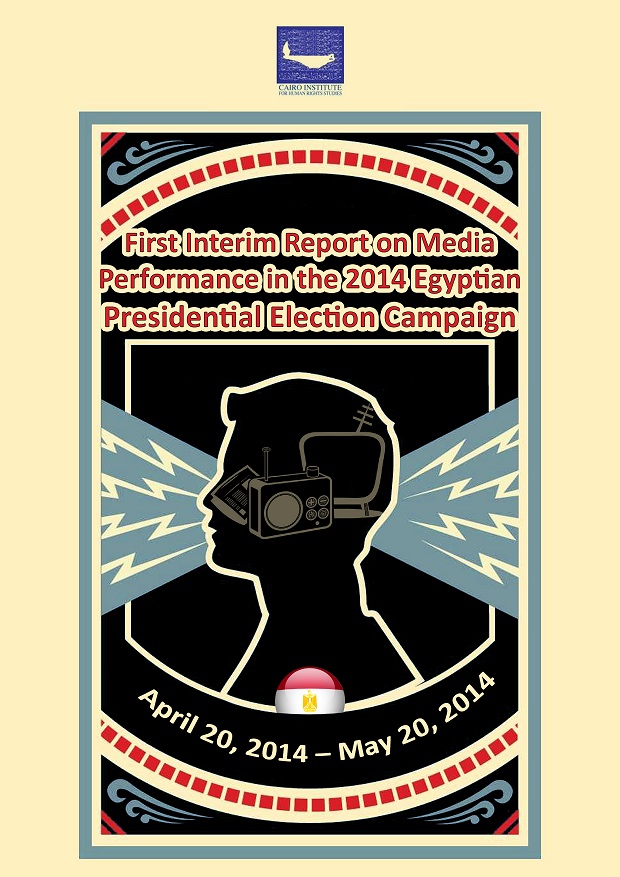 On May 22, 2014, the Cairo Institute for Human Rights Studies issued its media observatory’s first interim report assessing the performance of 15 media outlets during the Egyptian presidential election campaign from April 20, the deadline for filing candidacy, to May 20. CIHRS closely followed the course of the second presidential election in less than two years, held in a climate of heightened political polarization and violence unprecedented in Egypt’s modern history.
On May 22, 2014, the Cairo Institute for Human Rights Studies issued its media observatory’s first interim report assessing the performance of 15 media outlets during the Egyptian presidential election campaign from April 20, the deadline for filing candidacy, to May 20. CIHRS closely followed the course of the second presidential election in less than two years, held in a climate of heightened political polarization and violence unprecedented in Egypt’s modern history.
The presidential election was a test of media diversity and balance, but little diversity was in evidence, either among the media or the parties involved in the election process. This was especially so given the clear bias exhibited toward one party and after the closure of religious television channels and al-Hurriya wal-Adala newspaper. This election was therefore more of a test of genuine media balance in a context that favored the chances of one presidential candidate over the other.
The report examines the media’s observance of the principles of balance and neutrality, which go beyond simple issues of equal space and time in coverage, to address the way in which the news is formulated and introduced, the conclusions it shapes, and the manner in which it is laid out and produced. It also involves an assessment of the questions asked of each candidate and the interviewer’s ability to develop follow-up questions to respond to viewer’s needs. The report also examines the general climate in which the election was held and the most significant decisions and practices of the Presidential Elections Committee. In addition, it also reviews developments in the media environment, innovations in media programming, and the ramifications for coverage trends.
The 25-page report contains findings of CIHRS’s monitoring efforts, which included nine hours of daily, prime-time viewing of eight television channels (Egyptian Satellite Television, Nile News, CBC, ONTV, MBC Egypt, al-Jazeera Egypt, Sada al-Balad, and al-Qahera wal-Nas), nine hours of daily radio broadcast (Radio Egypt and Radio 90:90), and a review of five daily newspapers (al-Ahram, al-Gomhouriya, al-Shorouk, al-Masry al-Youm, and al-Watan). The report attempts to highlight the common features of these outlets’ coverage while also noting prominent breaches of professional standards by each outlet.
In general, the report finds that quantitatively, candidate Abd al-Fattah al-Sisi received more coverage than candidate Hamdeen Sabahi in all media outlets, including al-Jazeera. Al-Sisi was the subject of more news, viewing time, and column inches, as well as being more prominent in ads, programming breaks, and on the news ticker, reflecting a clear quantitative bias toward him. In terms of content, there was also a clear bias exhibited toward Sisi in numerous ways: he was consistently dubbed “the field marshal” rather than “the candidate”; several media figures and channels explicitly endorsed his candidacy; his stances and achievements as defense minister were regularly invoked; there was a clear discrepancy in the difficulty of questions and follow-up questions posed to him and his competitor in interviews; and production elements were used to favor him. Al-Jazeera used all these elements as well, but in order to depict Sisi negatively.
The report notes, however, the difficulty in drawing generalized conclusions about all media elements, private and state-owned, as there were some notable differences between public media outlets, and between public and private media sources. In addition, certain practices were linked with specific presenters, writers, or programs, making it difficult to come to one universal assessment of a single outlet, even on one day. As such, when discussing bias, the report cites, whenever possible, specific programs, headlines, and stories published in specific outlets on specific dates. The report also takes care to highlight the least biased and the most professional outlets and content.
CIHRS’s media observatory has monitored coverage of parliamentary and presidential polls and referendums since 2005. It monitored the performance of the Egyptian media in the run-up to parliamentary elections in 2005 and released a study on the media and parliamentary elections in January 2006. It has also prepared a report on media coverage of the 2010 parliamentary elections and another on the 2011 parliamentary elections, as well as three interim reports covering the campaign, vote, and runoff of the 2012 presidential poll. The observatory monitored media coverage of the referendum on the 2012 constitution and the 2014 referendum on the constitutional amendments, and issued interim reports on the constituent assembly’s work and the social dialogue on the charter.
Attachment:
First Interim Report on Media Performance in the 2014 Egyptian Presidential Election Campaign
Share this Post

